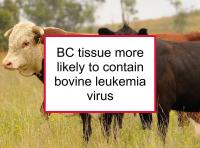Links between viral infection and cancer have been established for a number of viruses, among them hepatitis B and hepatitis C (liver cancer), human papilloma virus (HPV) (cervical cancer), human T lymphotrophic virus type 1 (HTLV-1) (T-cell leukemia), and Epstein-Barr (B and T cell lymphomas, Hodgkin’s disease, and other cancers).
Bovine leukemia virus (BLV)
BLV is a retrovirus closely related to HTLV-1 that infects the majority of U.S. beef and dairy cattle herds — one study estimated that 83% of dairy herds are infected with BLV. Western Europe is the only global region with strong and successful anti-BLV programs. BLV does not normally cause obvious illness in cattle and the majority of infected cattle are carriers with the virus in an apparent latent state. However, BLV depresses the immune system and produces a benign mononucleosis-like condition in at least 30% of infected animals. Only up to 5% of animals infected with BLV eventually develop leukemia (enzootic bovine leukosis) and only obviously ill animals are culled and removed from human consumption.
Beef labelled organic is not necessarily BLV-free. There is no efficient vaccine that can protect cattle against BLV infection. The majority of U.S. producers do not screen for BLV or actively try to reduce BLV incidence within their herds. This could change since BLV infection has been shown to reduce milk production and decrease longevity.
BLV is transmitted in cattle through the transfer of infected cells, especially in blood or milk. Cattle management procedures such as dehorning, ear tattooing, and reuse of infected needles are some common modes of transmission. Transfer of infected blood also appears to occur in regions with a high density of insects that feed on blood. In addition, prolonged direct contact between infected and healthy animals appears to be a risk factor for BLV transmission. BLV is transmitted to calves both in the womb and after birth (via colostrum and milk), although maternal antibodies present in the colostrum offer some protection to calves.
The majority of people in the U.S. carry BLV antibodies in their blood, indicating exposure to the virus. Although BLV-infected cells have been found in both beef and dairy products, heat and pasteurization destroy the virus. The presence of BLV antibodies does not necessarily mean active infection with BLV; the antibodies could be a response to heat-denatured BLV antigens consumed in food. However, raw milk and uncooked beef are possible sources of actual BLV infection. It is not clear to what extent handling raw beef during cooking (such as in making meatballs or preparing steak for grilling) could transmit the virus.
However, it makes sense to use the same precautions in handling raw beef that are currently recommended for raw chicken. Tasting raw ground beef mixtures during cooking preparation or consuming beef "rare" or as steak tartare could introduce risk of BLV infection. The authors of one study also raised the possibility that human-to-human transmission of BLV may be occurring.
Latest research reports BLV more likely in breast cancer patients
The study referenced above was designed to investigate whether BLV and HPV are associated with breast cancer, separately or in combination. To conduct the study, the authors tested for the presence of both BLV and HPV (i.e., targeted DNA segments of BLV and HPV) in 216 archival breast tissue specimens obtained from The University of Texas MD Anderson Cancer Center.
Breast cancer patients were found to be significantly more likely to have BLV DNA in their breast tissue than women with benign diagnoses and no breast cancer history. Women with premalignant breast pathology and no breast cancer history also were more likely to harbor BLV DNA. On the other hand, HPV status was not found to be associated with invasive breast cancer or premalignant breast disease. Nor did the authors find a significant association between the presence of HPV and the presence of BLV in the breast tissue samples.
The authors conclude that the current study results support previous findings of a significant association between BLV DNA in breast tissue and breast cancer. However, the study did not find oncogenic strains of HPV associated with breast cancer. The authors comment that the current study contributes to overall knowledge regarding a possible causal role for viruses in human breast cancer.
